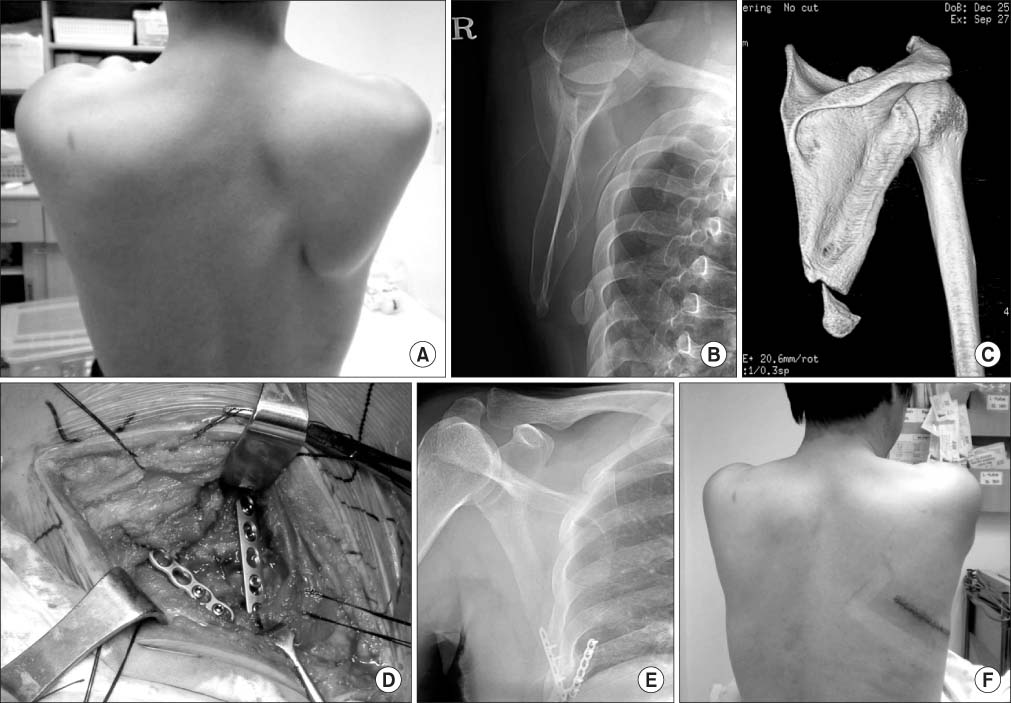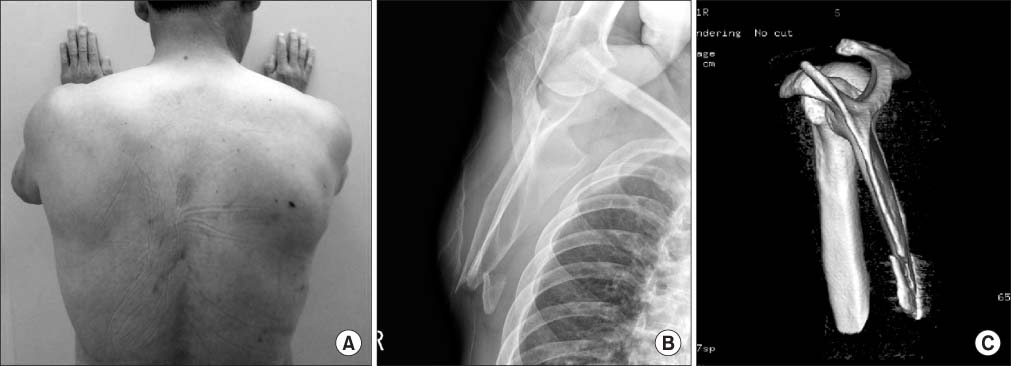J Korean Orthop Assoc.
2014 Apr;49(2):165-171. 10.4055/jkoa.2014.49.2.165.
Treatment of Scapula Fractures of the Inferior Angle Causing Pseudowinging Scapula
- Affiliations
-
- 1Department of Orthopedic Surgery, Soonchunhyang University College of Medicine, Seoul, Korea.
- 2Department of Orthopepic Surgery, Sungae Hospital, Seoul, Korea. hwangseokha@naver.com
- KMID: 2185223
- DOI: http://doi.org/10.4055/jkoa.2014.49.2.165
Abstract
- Nonoperative treatment of scapular body fractures has shown good clinical results. Although scapula fractures of the inferior angle, particularly with oblique lines from the medial proximal to lateral distally, are very rare, we believe that such a fracture pattern would be regarded as an avulsion fracture of the serratus anterior muscle requiring surgery. We have experienced three cases demonstrating pseudowinging of the scapula due to displacement of the inferior angle fracture of the scapula. Surgical repair or plating showed satisfactory clinical results. Through these cases, we describe the cause of winging scapula and the problems resulting from an avulsion fracture of the serratus anterior muscle with a review of the relevant literature and explain the reason that an operation is needed for this fracture pattern.
MeSH Terms
Figure
Reference
-
1. Zlowodzki M, Bhandari M, Zelle BA, Kregor PJ, Cole PA. Treatment of scapula fractures: systematic review of 520 fractures in 22 case series. J Orthop Trauma. 2006; 20:230–233.
Article2. Hayes JM, Zehr DJ. Traumatic muscle avulsion causing winging of the scapula. A case report. J Bone Joint Surg Am. 1981; 63:495–497.
Article3. Heyse-Moore GH, Stoker DJ. Avulsion fractures of the scapula. Skeletal Radiol. 1982; 9:27–32.
Article4. Brindle TJ, Coen M. Scapular avulsion fracture of a high school wrestler. J Orthop Sports Phys Ther. 1998; 27:444–447.
Article5. Bowen TR, Miller F. Greenstick fracture of the scapula: a cause of scapular winging. J Orthop Trauma. 2006; 20:147–149.
Article6. Mansha M, Middleton A, Rangan A. An unusual cause of scapular winging following trauma in an army personnel. J Shoulder Elbow Surg. 2010; 19:e24–e27.
Article7. Gaffney KM. Avulsion injury of the serratus anterior: a case history. Clin J Sport Med. 1997; 7:134–136.8. Otoshi K, Itoh Y, Tsujino A, Hasegawa M, Kikuchi S. Avulsion injury of the serratus anterior muscle in a high-school underhand pitcher: a case report. J Shoulder Elbow Surg. 2007; 16:e45–e47.
Article9. Hamada J, Igarashi E, Akita K, Mochizuki T. A cadaveric study of the serratus anterior muscle and the long thoracic nerve. J Shoulder Elbow Surg. 2008; 17:790–794.
Article10. Franco M, Albano L, Blaimont A, Barrillon D, Bracco J. Spontaneous fracture of the lower angle of scapula. Possible role of cough. Joint Bone Spine. 2004; 71:580–582.
Article
- Full Text Links
- Actions
-
Cited
- CITED
-
- Close
- Share
- Similar articles
-
- Management of Extra-articular Scapular Fractures: A Narrative Review and Proposal of a Treatment Algorithm
- Operative Treatment of Winged Scapula: A Report of 2 Cases
- Hemangioma of the Scapula Associated with High Scapular Deformity: Case Report
- Isolated Avulsion Fracture of the Superior Border of the Scapula: A Case Report
- Sprengel's Deformity: A case Report




